IN PARTNERSHIP WITH ROLEX
From monkey chatter to raindrop patter: How one scientist reads the Amazon’s health through its sounds
Supported by the Rolex Perpetual Planet Initiative, bioacoustics researcher Michel Andre deploys a sensor network across the rainforest to record the sounds to monitor the ecosystem and champion its conservation
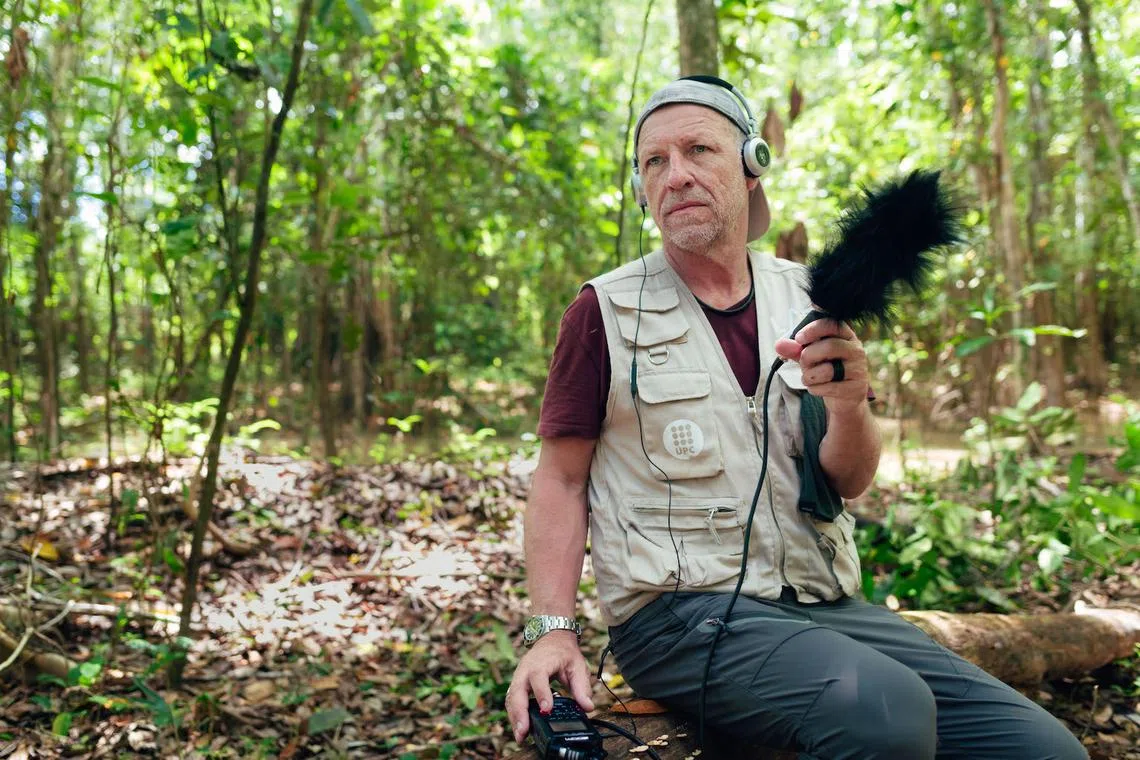
French bioacoustics scientist and 2002 Rolex Awards Laureate Michel Andre, is installing acoustic sensors in the Amazon rainforest to monitor its health.
PHOTO: ROLEX/DIEGO BRESANI
Follow topic:
The next time you are in the Bukit Timah Nature Reserve, close your eyes and open your ears.
The sounds of the wildlife can tell you a lot about the state of its ecosystem, says French bioacoustics scientist and 2002 Rolex Awards Laureate Michel Andre
He points out that the Amazon rainforest is one of the world’s most important natural ecosystems, but is under constant threat.
The 61-year-old says: “It contains half of the planet’s tropical forests, and is home to over three million species, including the greatest diversity of plant species. It is also one of the last refuges for many endangered species, such as the jaguar and pink dolphin.
“It also plays a key role in Earth’s climate. The Amazon River system alone holds about 20 per cent of all unfrozen freshwater. Still, we are losing large parts of the forest to logging, mining and other issues. About 20 per cent of it is already gone.”
That is why he partnered Mr Emiliano Esterci Ramalho, scientific director of the Mamiraua Institute for Sustainable Development, to launch Project Providence in 2016.
The initiative aims to record the Amazon’s sounds in real time, across the nine countries that the rainforest spans: Brazil, Columbia, Venezuela, Ecuador, Peru, Bolivia, Suriname, Guyana and French Guinea.
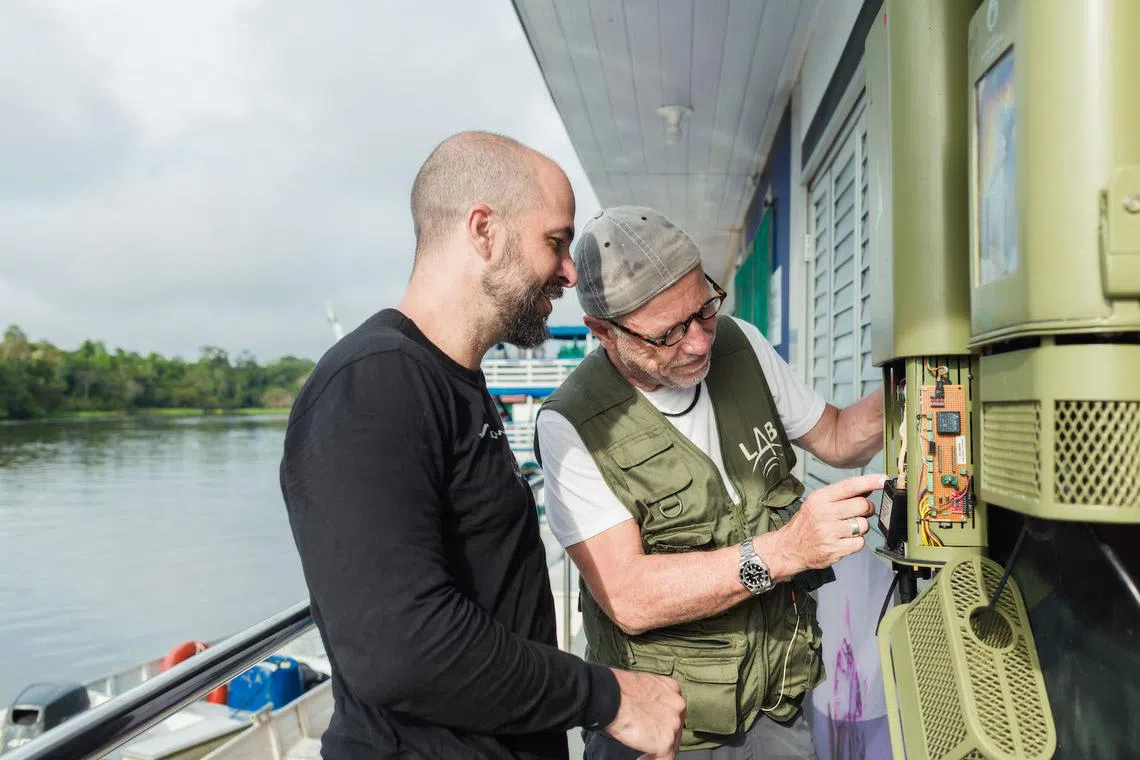
Mamiraua Institute for Sustainable Development scientific director Emiliano Esterci Ramalho (left) and Mr Andre work together to check and fix their bioacoustic nodes in the Mamiraua Sustainable Development Reserve. PHOTO: ROLEX/DIEGO BRESANI
Mr Andre is the director of the Laboratory of Applied Bioacoustics at the Technical University of Catalonia in Barcelona, while the Mamiraua Institute manages the Mamiraua Sustainable Development Reserve in the Brazilian Amazon. The two organisations are using the sensors’ data to study the impact of climate change and human activities on the Amazon’s species.
A healthy forest is a symphony of sounds, with each species contributing its unique acoustic signature across different frequencies. Through bioacoustics monitoring, scientists can track the presence and behaviour of various species, creating a comprehensive picture of biodiversity.
By tracking the Amazon’s soundscape – from its birds’ songs to the drumming of rainfall on treetops and primate chatter – Project Providence aims to collect information on the forest’s flora and fauna, and share it with other scientists and the authorities.
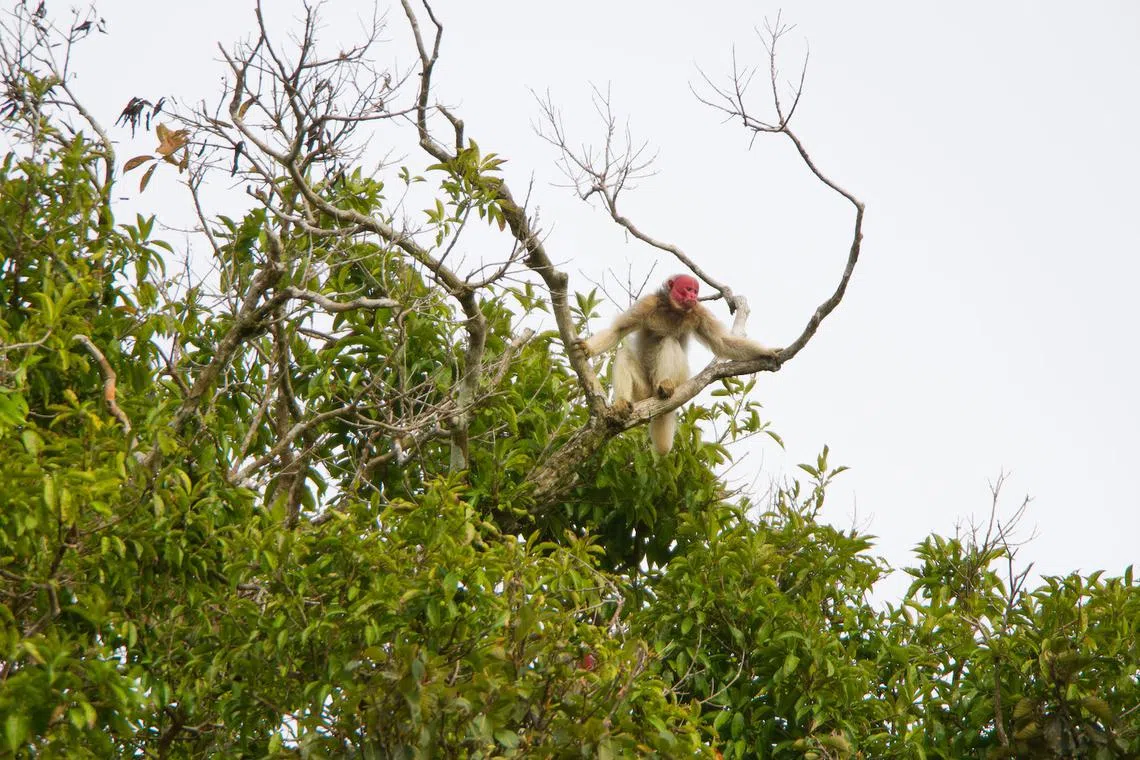
The uakari monkey lives in the Mamiraua Sustainable Development Reserve but its numbers are declining because of various reasons including deforestation. PHOTO: ROLEX/DIEGO BRESANI
If certain frequencies fall silent or become less complex, it often signals environmental stress or habitat degradation, before any visible signs appear. This makes acoustic monitoring an invaluable warning system for forest health, and is useful for scientists and authorities to develop more informed public policies to protect at-risk areas and species.
The team plans to have 1,000 sensor stations across the Amazon rainforest by 2025 to record and transmit sounds and video in real time.
While conventional surveying tools such as remote sensing satellites can map the forest’s canopy, the powerful and sensitive sensors will go further by producing a vivid and accurate picture of the reality on the ground.
Two conservation pioneers, one mission
The seeds of Mr Andre’s collaboration with the Mamiraua Institute were sown when he was amazed by the reserve’s beauty – and surprised by an unexpected connection – during his visit in 2013.
The late Brazilian primatologist and conservationist Jose Marcio Ayres, who founded the institute and reserve, was a fellow 2002 Rolex Awards Laureate. Although he passed away in 2003, he left behind a team dedicated to his legacy, including Mr Ramalho. Inspired by their commitment, Mr Andre decided to lend his bioacoustics expertise to support the institute in strengthening and expanding its work.
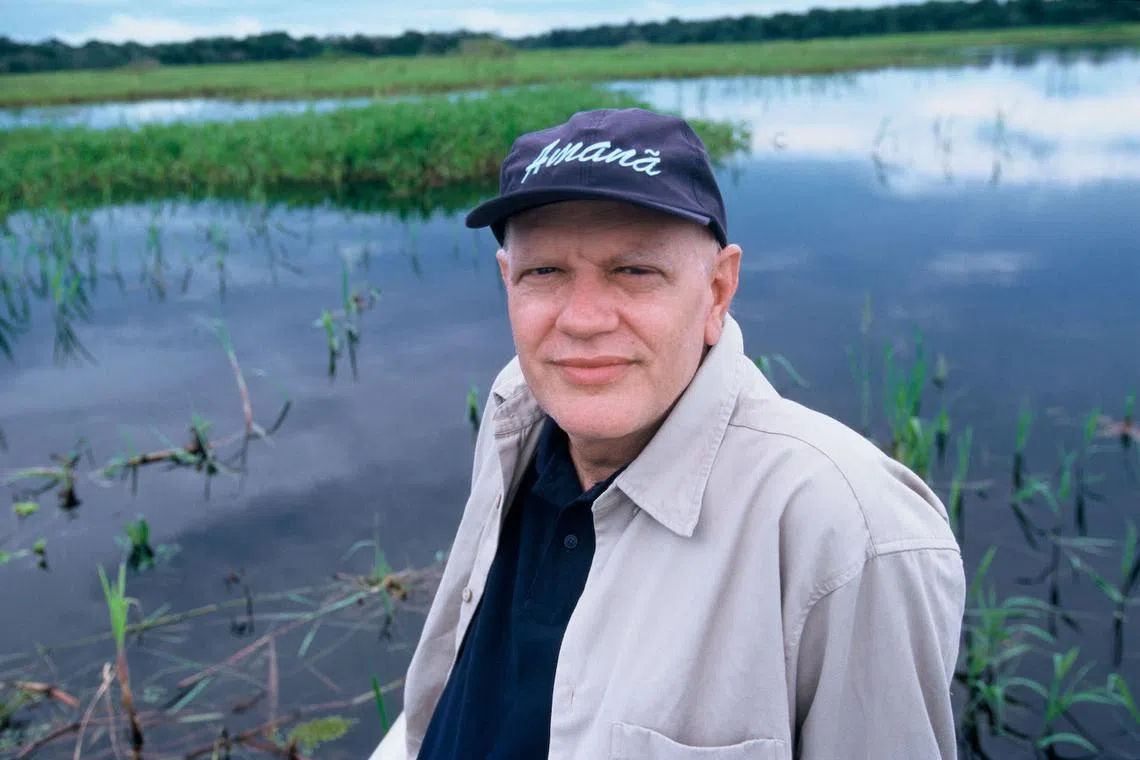
The late Mr Jose Marcio Ayres won a 2002 Rolex Award, the same year as Mr Andre, for establishing the Mamiraua Reserve in the Brazilian Amazon. PHOTO: ROLEX/MARC LATZEL
Every year, the Project Providence team retrieves the sensors from their locations deep in the forest and takes them to a mobile laboratory on a customised riverboat for maintenance. The team is also training and using artificial intelligence (AI) to identify individual species and sounds amidst the cacophony, and analyse the data.
Mr Andre emphasises the data’s many uses. The team can compare the state of the ecosystem in different parts of the forest. For example, they can pit areas of tropical forest in Mamiraua isolated from people against those closer to the busy Manaus city, to better understand how wildlife species adapt to human influence.

These nodes are placed throughout the reserve in order to capture images and sounds of its wildlife. PHOTO: ROLEX/DIEGO BRESANI
Insects play a critical role in maintaining natural ecosystems, from consuming plants and animals and breaking down the organic matter to nourish soil, to transporting seeds and pollinating plants. Their quieting could thus highlight problems in the environment that need to be solved, such as harmful chemicals, fires or urban light affecting their night-time routines.
With the Mamiraua Institute already teaming up with local people on the reserve’s conservation, the communities could also rely on the sensor network to flag illegal activities. For instance, the AI system could alert them and the authorities to sounds of motorboats and saws used for logging, in areas that the government wants to safeguard.
The Amazon in sound health
Project Providence, started by Rolex Awards Laureate Michel Andre in partnership with the Mamiraua Institute for Sustainable Development, aims to track the Amazon’s ecosystem and the effects of climate change and human activities using sounds. Here, these figures explain why the project is necessary and will be beneficial to the flora and fauna as well as local communities.
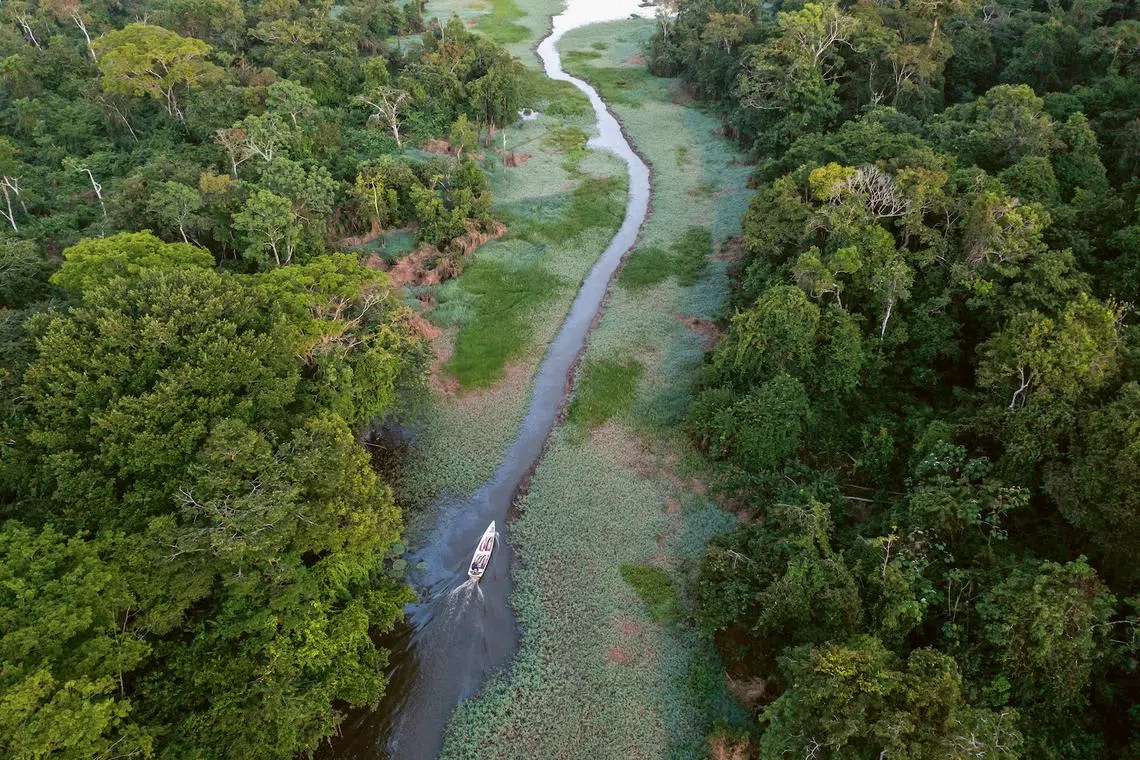
The Amazon rainforest (an aerial view of a floodplain) spans nine countries and is home to people, animals and plants. PHOTO: ANDRE DIB/NATIONAL GEOGRAPHIC
André Dib/National Geographic
2.2 million The number of indigenous people the Amazon biome is home to. They come from over 500 distinct groups, who depend on the forest for their livelihoods.
10,267 sq km The area of vegetation the Brazilian Amazon lost in 2022. It is about the size of Lebanon.
> 1,000 The number of species Project Providence has acoustically and visually identified to date.
1,000 Number of sensor stations Project Providence aims to have across the Amazon rainforest by 2025.
18% The percentage of the Amazon rainforest that has been completely lost. An additional 17 per cent has been damaged due to deforestation.
10 sq km The area monitored by each Project Providence node.
Sources: Project Providence and Science Panel for the Amazon
Saving the environment, side by side
Such cooperation is key to conservation, Mr Andre says, noting that Project Providence is also more impactful with both his laboratory and the Mamiraua Institute on board.
He also credits Rolex, which has been supporting pioneering explorers to push the boundaries of human endeavour for nearly a century, for furthering his work and that of the late Mr Ayres via the Rolex Awards.
With climate change and other issues threatening the world’s natural ecosystems, the Swiss watchmaker has moved from championing exploration for the sake of discovery to protecting the planet. It is committing for the long term to empower individuals and organisations that are using science to illuminate and address today’s environmental challenges.

The Project Providence climbing team scales a tree to reach one of the nodes that are collecting sounds to quantify and assess – in real time – the wildlife in the reserve. PHOTO: ROLEX/DIEGO BRESANI
It reinforced this engagement in 2019 with its Perpetual Planet Initiative, which initially focused on the Rolex Awards and longstanding partnerships with the National Geographic Society and Mission Blue. Legendary oceanographer Sylvia Earle, who is also a Rolex Testimonee, founded and leads the latter organisation to explore and protect oceans.
The Initiative now has a diverse and growing portfolio of over 30 partnerships, concentrating on ocean conservation, wilderness protection and the living world’s preservation, including with Rewilding Argentina and Rewilding Chile, which protect landscapes in South Africa, Under The Pole expeditions for underwater exploration, and Rolex Awards
Rolex also advances organisations and initiatives fostering the next generations of explorers, scientists and conservationists through scholarships and grants.
These span the Our World-Underwater Scholarship Society and The Rolex Explorers Club Grants that nurture talented young people and enable them to gain experience in their chosen fields, and more.
Mr Andre himself hopes that generations of researchers, volunteers and communities will use his sensors to help ensure the Amazon’s healthy longevity, and Project Providence will inspire others to protect the future of the planet through conservation.

Through Project Providence and their research, the Mamiraua Institute team is starting to build a multi-layered picture of biodiversity and habitat in the Amazon rainforest. PHOTO: ROLEX/DIEGO BRESANI
After all, one conservation project can enrich and complement another, even across decades, just like how Mr Ayres’ pioneering work in Mamiraua has found a whole new dimension, 20 years after his death, in Project Providence, with an assist from a fellow Rolex Awards Laureate.
Mr Andre says in an Instagram post
“Our goal is to propose viable solutions for harmonious coexistence with nature, steering clear of an irreversible tipping point.”
We The Earth Rolex and its Perpetual Planet Initiative

